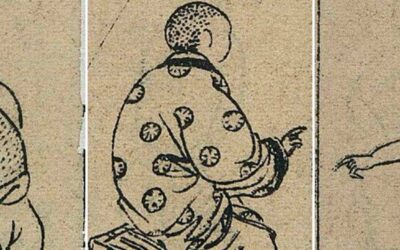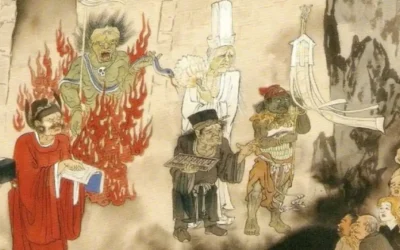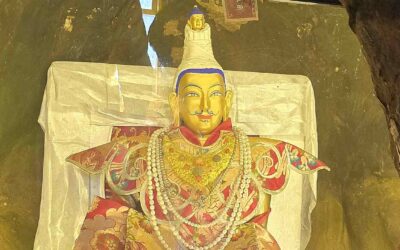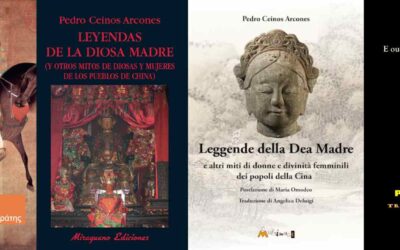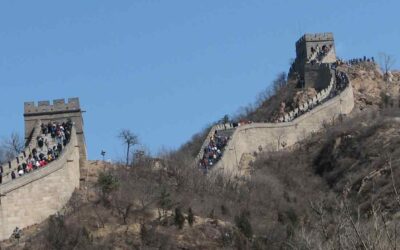The Qingming Festival: From Spring Celebration to Festival of the Dead
The Qingming Festival (清明节) is today China’s Day of the Dead—the time when people remember their deceased relatives and travel to cemeteries located on the outskirts of cities, or to tombs built in mountainous areas with good fengshui, to clean their ancestors’ graves and leave fresh offerings. In some cities, like Kunming in Yunnan, people make offerings to their ancestors near the places where they once lived, burning hell money and gold and silver ingots made of paper.
Money for the spirits of the ancestors
The offerings left at the graves or burned in their honor are meant to provide the souls of the ancestors with money to meet their needs in the afterlife—and above all, to bribe the infernal officials to ensure kinder treatment and an earlier reincarnation. According to Chinese tradition—originally Buddhist and later also Taoist and folk—after death, the soul is judged, and after suffering the punishments corresponding to its misdeeds in life, it will be reborn in another living being.
The ancient roots of Qingming
This festival has been celebrated in China since time immemorial and is the result of a fascinating blend of agricultural, philosophical, and ritual elements that evolved over time.
Its transformation from a springtime festival into one dedicated to the dead is the result of several cultural layers overlapping over centuries. Here’s how it happened.
Qingming means «clarity and brightness» and is one of the 24 solar terms in the traditional Chinese calendar that mark key moments in the agricultural year. It usually takes place in early April and signals the beginning of a favorable time for sowing, prompting farmers to prepare their fields.
Originally, then, Qingming was a spring festival linked to nature and the agricultural cycle—not to the dead.
Another festival sought to honor the soul of a suicide
Before the Tang dynasty (7th to 10th century), there was another festival called Hanshi Jie (寒食节), or “Cold Food Festival,” celebrated just before Qingming to honor Jie Zitui—a controversial figure in Chinese history and legend. He took loyalty to such an extreme that he let himself burn to death in the forest where he had retreated, rather than forgive his king for failing to reward his past service. We will tell his story in detail another time.
What matters here is that, following ancient Chinese beliefs that the spirits of those who die violent deaths are extremely powerful—and that if such a death was due to injustice, they might seek vengeance among the living—this festival arose. In mourning for Jie Zitui’s sad death, people refrained from lighting fires and ate only cold food. Ceremonies were held in his honor in various places, and some made pilgrimages to Mount Mianshan in Shanxi province, where he had died.
From honoring a suicide to honoring all ancestors
During the Han dynasty, the Cold Food Festival began to blend with popular funeral practices. People began to honor their own ancestors as well: cleaning their graves and offering cold food to their spirits.
Because tombs were not located in the same places where people lived, but rather in scenic areas with good fengshui, this practice turned into a countryside outing that included a family meal and leisure activities like kite flying or composing poetry. In some regions, sporting competitions were also held.
Three traditions merged into one festival
The spring festival, the tribute to Jie Zitui, and the tomb-sweeping rituals for the ancestors gradually merged during the Tang dynasty into a single celebration. It kept its original name—Qingming—but took on a newer meaning: a time to honor the deceased.
Religious and festive rituals were held around the tombs, especially tomb sweeping, often decorated with flowers, and the traditional family outing in nature.
Celebrating both life and death
This fusion of two seemingly opposite festivals—one celebrating life, the other death—actually reflects a continuous view of existence that permeates Chinese culture.
Just as nature renews itself each year with plants dying in winter and being reborn in spring, so too do humans die only to be reborn after passing through the underworld to atone for their faults.
To celebrate Qingming is therefore to celebrate not only nature’s renewal but also the rebirth of ancestors into a new life.
Orgies to celebrate spring’s arrival
Marcel Granet and other scholars, in their studies of the Book of Songs (Shijing), the oldest of Chinese books, suggest that during early spring rituals, the ancestors were actually believed to return to life.
At that time, it was thought that after death, the souls went to the Yellow Springs beneath the earth, and that the springtime torrents from melting snow carried the essence of the ancestors through the fields.
Young women would bathe in these rivers and absorb their essence, then go in search of a partner with whom to share their life.
Honoring the dead so the living may prosper
In later times, those ideas faded, but the belief remained that the ancestors’ souls could bring prosperity to their descendants. Every ceremony held in their honor became part of a kind of family contract: the living cared for the dead, feeding their souls with offerings, and the dead looked after the living in return—because it was also in their interest to keep receiving offerings and avoid becoming suffering, hungry ghosts.
Its festive character was forever immortalized in art
A graphic proof that the Festival of the Dead eventually became a celebration of life is provided by the magnificent painting «Along the River During the Qingming Festival», a huge handscroll measuring 528 cm in length and 24.8 cm in height by the Song dynasty painter Zhang Zeduan. It captures the lively atmosphere of the capital at the time, Kaifeng. Thousands of people stroll through the streets, enjoy the shops and restaurants, or take boat rides along the river, with the vibrant energy that only an Eastern celebration can convey. It is no surprise that it is considered one of the greatest paintings in Chinese history.
Since this is getting quite long, we’ll talk about Jie Zitui another day.
About me: I have spent 30 years in China, much of the time traveling and studying this country’s culture. My most popular research focuses on Chinese characters (Chinese Characters: An Easy Learning Method Based on Their Etymology and Evolution), Matriarchy in China (there is a book with this title), and minority cultures (The Naxi of Southwest China). Yo can see my mis videos in Youtube, and more pictures about China in Instagram (pedroyunnan).
In travel, I have specialized in Yunnan, Tibet, the Silk Road, and other lesser-known places. Feel free to write to me if you’re planning a trip to China. The agency I collaborate with offers excellent service at an unbeatable price. You’ll find my email below.
Last posts
The Smallpox Goddess (Doushen)
The Smallpox Goddess (Doushen) The Smallpox Goddess (Doushen 痘神) is part of a group of goddesses whose primary role was the protection of children. In the final years of the imperial era, they operated under the authority of Bixia Yuanjun, the daughter of the Emperor...
The Solution to the West’s Suicide Epidemic Can Be Found in the Culture of a Himalayan People
The Solution to the West’s Suicide Epidemic Can Be Found in the Culture of a Himalayan People In recent years, the number of suicides among young people has skyrocketed. In some countries, such as Spain, suicides have already surpassed traffic accidents as the leading...
Drak Yerpa: The Tibetan Cliffs of Meditation
Drak Yerpa: The Tibetan Cliffs of Meditation A visit to the cliffs of Drak Yerpa, about 30 kilometers from Lhasa, not only offers a glimpse of the beauty of the Tibetan landscape and some rural settlements near the capital, but also gives us the chance to explore one...
Great Taoist magician Liu Zheng
Great Taoist magician Liu Zheng Liu Zheng was a native of Pei[1]. Endowed with extraordinary talent and vast learning, he left no branch of knowledge unexplored. Profoundly reflecting on the human condition, he concluded that worldly honors and riches endure but a...
Legends of the Mother Goddess
Legends of the Mother Goddess I am pleased to share with all you that the Italian translation of my book Legends of the Mother Goddess (and Other Myths of Goddesses and Women from the Peoples of China) has now been published and is available for purchase. As many of...
The truth about the Great Wall
The truth about the Great Wall What would later come to be known as the Great Wall formed as a response to increased Mongol raiding after Esen was killed in 1455. Having failed to capitalize on the capture of Zhengtong, Esen lost the political momentum that had held...





